In the world of business, companies keep a close eye on their assets and liabilities to maintain financial transparency. Now, this same level of accountability is extending to the environment, with fashion brands and suppliers becoming more responsible for tracking and reducing their carbon footprint.
So, what's driving this change?
Many companies in our industry are doing Carbon Accounting because climate responsibility is part of their DNA and a way to differentiate in the market.
And many brands have pledged to the Science-Based Targets initiative (SBTi), which involves measuring their carbon footprint and setting targets to reduce it to meet the goals of the Paris Agreement.
What’s more, some banks are now starting to tie loan interest rates to climate performance, incentivizing companies to track and reduce their emissions for more favorable rates.
However, without accurate measurements, it's impossible to set meaningful reduction targets or implement effective mitigation strategies. That’s where carbon accounting comes in.
Carbon Accounting Demands Shift Over Time
Each year in the footwear and apparel sector, more and more fashion companies dip their toes into Carbon Accounting for the first time. Quickly after seeing the data, the realization sets in that Scope 3.1 (purchased goods and services) dominates – making accurate data collection and categorization essential, since 90% of your emissions as a fashion brand stem from here. Without accuracy on the biggest emissions culprit, data isn’t defensible nor accurate.
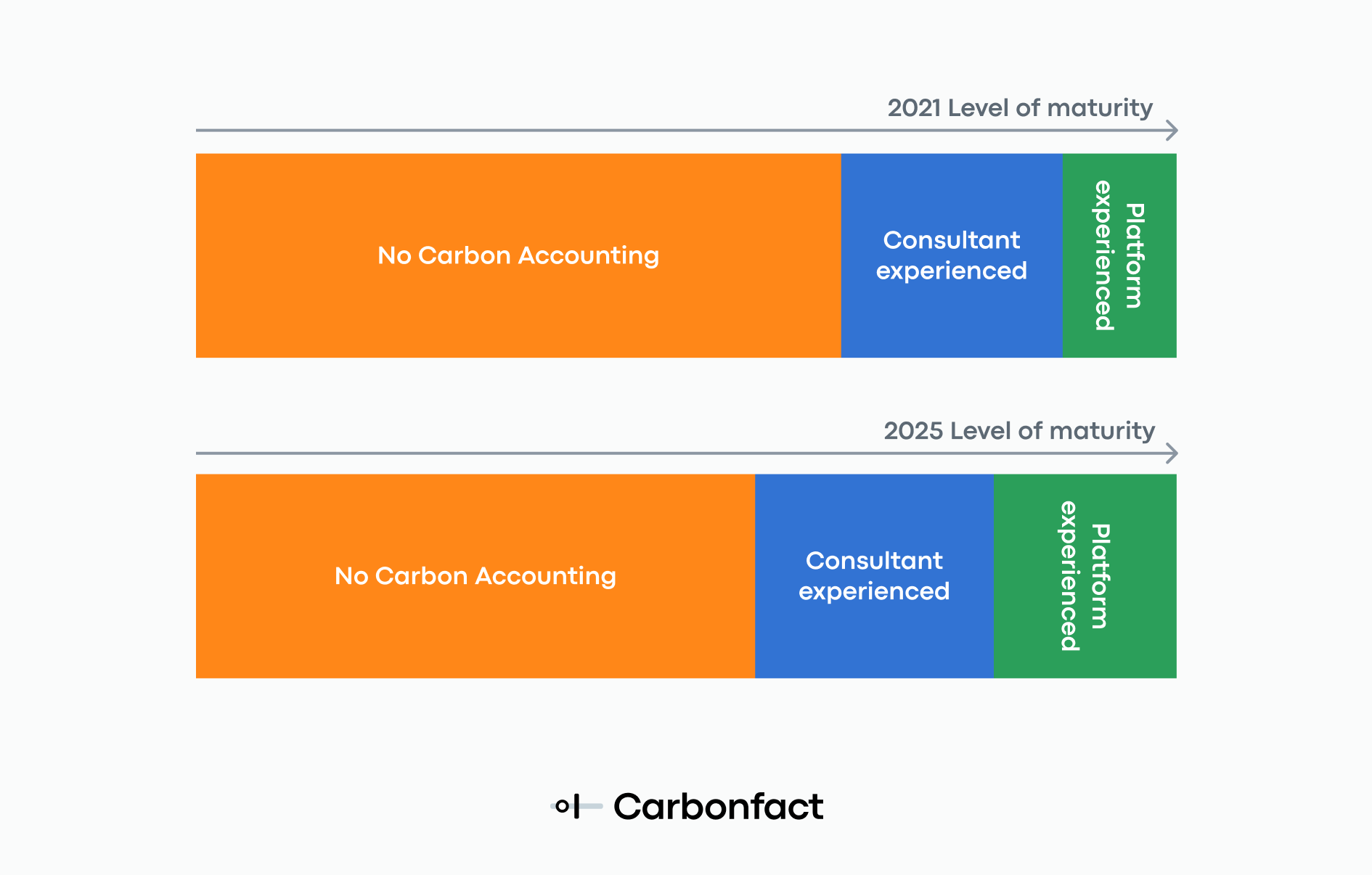
At the same time, organizations and their sustainability teams are dealing with increased “time crunches” and budget restrictions, needing to do more with less. One of the core questions, then, is “how accurate is accurate enough if we’re doing it for the first, or one of the first, times?”
The right approach determines not only accuracy but also how efficiently results can be updated each reporting cycle.
What Is Carbon Accounting?
First, let’s take a step back. Carbon accounting is the process of tracking and measuring the amount of greenhouse gases (GHG) emitted by an organization or activity. This includes carbon dioxide (CO2), methane (CH4), nitrous oxide (N2O), and fluorinated gases. Gases other than CO2 are converted into carbon equivalents (CO2eq).
Just as financial accounting paints a picture of a company's financial health, carbon accounting provides a detailed assessment of its carbon footprint.
The main question is: what is included in the scope of this measurement and how far the boundaries for the activities should be set? For fashion and footwear brands, this can be a particularly challenging task. Unlike direct emissions from company-owned facilities, the majority of a clothing company's emissions comes from indirect sources, like garment production, transportation, and waste disposal. In fact, over 90% of a fashion brand’s total carbon footprint can come from indirect sources. This, coupled with a complex supply chain, makes it difficult to pinpoint the exact sources of emissions.
As a result, many fashion brands and suppliers don’t know where to start with carbon accounting, but don’t worry, we’re here to help. This article will cover everything you need to know, from understanding the different scopes to selecting the best carbon accounting platform for your needs.
.png?width=562&height=322&name=CA%20(1).png)
In the fashion industry, most emissions stem from Scope 3.
Decoding the GHG Protocol (Scope 1, 2, 3)
The Greenhouse Gas Protocol (GHG Protocol) has introduced a standardized methodology for measuring greenhouse gas emissions in the form of global warming potential (GWP), which defines the scope and boundaries of the assessment. Let’s take a quick look at what each scope includes:
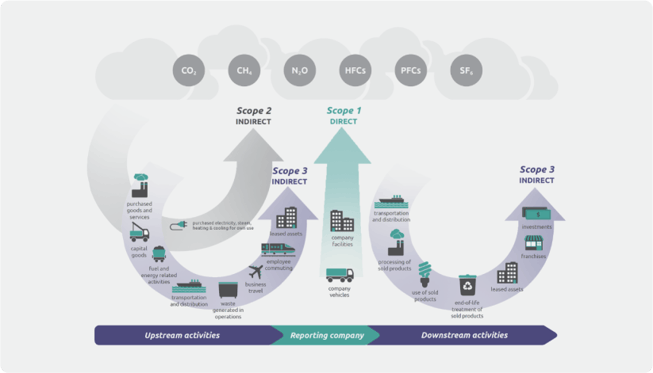
Source: Corporate Value Chain (Scope 3) Accounting and Reporting Standard, page 5.
Scope 1: Direct emissions
Scope 1 emissions encompass GHGs directly emitted from sources owned or controlled by the reporting organization or institution. These emissions arise primarily from the combustion of fuels, such as gasoline, diesel, or natural gas, in company-owned vehicles, boilers, furnaces, or generators. The direct nature of these emissions stems from the organization's direct control over the fuel combustion process.
While fashion companies typically don't produce their own energy or own their own production factories, they still produce direct emissions that contribute to their overall carbon footprint, such as emissions from their own facilities (offices, warehouses, etc.) and any vehicles they own.
.png?width=586&height=335&name=CA%20(4).png)
Overview of all GHG Scope 1 categories
Scope 2: Indirect emissions
Scope 2 emissions are indirect GHGs that arise from the consumption of purchased or acquired energy sources, such as electricity, heating, cooling, and steam. These emissions are considered indirect because the apparel company does not directly burn the fuels that generate the energy. Instead, the organization purchases the energy from a third-party suppliers, such as a utility company, which provides energy for fashion retail stores, offices and warehouses.
.png?width=578&height=331&name=CA%20(5).png)
Overview of all GHG Scope 2 categories
To ensure accurate reporting, the Greenhouse Gas Protocol provides two methods to calculate Scope 2.
1. Location-Based Method
- Calculates emissions using the average emissions intensity of the local electricity grid where the energy is consumed.
- Data Source: Regional or national grid-average emission factors.
- Use Case: Represents the physical reality of grid electricity consumption and its associated emissions.
- Example: A textile supplier in Germany would use the national grid emission factor to estimate its Scope 2 emissions. A company in the US would use the Regional/state emission factor.
-
Advice: Use the location-based method if you do not yet have renewable energy contracts in place.
2. Market-Based Method
- Definition: Reflects emissions based on the specific electricity contracts a company purchases, such as renewable energy certificates (RECs) or power purchase agreements (PPAs).
- Data Source: Supplier-specific emission factors or contractual instruments.
- Use Case: Allows organizations to account for their choice of electricity sourcing, distinguishing between conventional grid electricity and renewable energy.
- Example: If a fashion brand purchases 100% renewable energy through a PPA, it may report 0 emissions under the market-based approach.
-
Advice: Use the market-based method if your company is actively purchasing renewable electricity (e.g., PPAs, RECs, green tariffs).
In market-based Scope 2 reporting, fashion brands either apply renewable energy emission factors or the residual mix when they do not. The residual mix is the share of grid electricity left after all renewable energy claims have been removed – essentially the unclaimed mix of fossil, nuclear, and other sources.
Use Renewable Energy Emission Factors When: Companies should apply zero or low-carbon emissions factors when they have valid contractual instruments proving renewable energy procurement. This includes:- Power Purchase Agreements (PPAs): A direct contract with a renewable energy producer.
- Energy Attribute Certificates (EACs): Such as Renewable Energy Certificates (RECs) in North America or Guarantees of Origin (GOs) in Europe.
- Utility Green Tariffs: A supplier-provided green energy program where renewable attributes are retained by the buyer.
Example: If a company purchases 100 MWh of wind power via a PPA, it can report zero emissions for that 100 MWh under the market-based method.
Key Requirement: The contractual instrument must meet the GHG Protocol Scope 2 Quality Criteria, ensuring it is:
- Legitimate (i.e., not double-counted or expired).
- Supplier-Specific (reflecting actual energy purchased).
- Regionally Appropriate (certificates must be from the same country or interconnected market).
Use Residual Mix Emission Factors When: If a company does not have specific renewable energy contracts or the purchased electricity does not include recognized environmental attributes, it must use the residual mix factor for emissions calculation.
Residual Mix refers to the portion of electricity on the grid that remains after removing renewable energy claims (e.g., RECs, Guarantees of Origin). It represents the unclaimed mix of fossil, nuclear, and other energy sources in the market-based accounting method.
Scope 3: Upstream and downstream emissions
Scope 3 emissions result from GHGs emitted indirectly by activities that are not directly owned by the textile brand but occur within its value chain. These emissions originate from some upstream and all downstream activities. Upstream emissions are associated with the fashion brand's suppliers and the production of goods or services, while downstream emissions are related to the use, distribution, and disposal of those goods or services.
In the apparel and footwear industry, on average, 80-96% of emissions stem from Scope 3 across textile brands with approved science-based targets (SBTs), with Category 1 "Purchased goods and services" making up the largest portion of the overall emissions.
This category covers all the products, materials, and services a textile brand buys to make and sell its own products or services—including everything from raw materials like cotton or leather to transportation services like shipping and trucking. The complexity of the value chain and having access to the emission data throughout the supply chain is one of the biggest challenges for evaluating Scope 3 emissions.
.png?width=610&height=349&name=CA%20(6).png)
Overview of all GHG Scope 3 categories
Calculating the Total Corporate Carbon Footprint
By adding up emissions from all three scopes, you get a comprehensive picture of your fashion company’s overall carbon footprint. This information is crucial for developing effective decarbonization strategies and aligning with established corporate reporting standards like ESRS, ISSB, CDP, GRI, and VSME.
.png?width=602&height=344&name=CA%20(3).png)
Carbonfact GHG Protocol report feature. Learn more.
Reporting Period: Fiscal Year vs. Calendar Year
Brands can report emissions using either a calendar year or a fiscal year, and both approaches are accepted under major reporting frameworks.
At Carbonfact, we recommend reporting on your fiscal year. Most companies already collect financial data – such as spend on purchased goods, logistics, and facilities – according to their fiscal year. Aligning carbon accounting with the same period reduces complexity and makes it easier to link emissions data with business decisions and investments.
The most important principle is consistency – whichever period you choose, keep it year over year to enable meaningful comparison of your emissions trends.
Different Methods of Carbon Accounting
As defined by the GHG Protocol, various methods can be employed to measure GHG emissions. Each method offers distinct advantages and limitations, and the choice of method depends on factors such as the nature of the data available, the specificities of the industry or company, and the desired level of accuracy.
1. Spend-based method for GHG Carbon Accounting
Companies of all sizes use the spend-based method to estimate their emissions. As the name suggests, this method relies on financial data. This approach involves multiplying the financial expense of a product or service by an emission factor. Emission factors vary depending on the product or activity and are typically provided by a government agency or organization, such as the European Environmental Agency.
Accuracy level: Generally low to moderate
Reason: Spend-based emission evaluations have two core problems. The first is that prices for lower-impact materials can be higher than those of their high-impact counterparts. There are cases where recycled polyester costs more, which means by virtue of scope your emissions are larger – even though the material has far less impact. Secondly, as this method relies on economic data and average emission factors, it can result in broad estimates. The actual emissions may deviate considerably from these averages, particularly in industries with diverse activities such as fashion. Moreover, due to frequent price fluctuations, this method is not a reliable tool for calculating accurate emissions and building decarbonization strategies.
2. Activity-based method for GHG Carbon Accounting
Activity-based accounting calculates how much greenhouse gas is generated by specific activities. Compared to spend-based accounting, activity-based data goes beyond financial metrics and incorporates a wider range of activity-specific data points, including measurements such as material weight, vehicle mileage, and units sold.
For instance, it can be used to quantify how much CO2 is released during transportation (kg CO2-eq per km), using electricity (kg CO2-eq per kWh), or manufacturing clothes (kg CO2-eq per kg of textile).
Accuracy level: Moderate to high
Reason: Activity-based data offers a more granular view of emissions sources, drawing on data from diverse sources, including direct measurements from entities across the supply chain. The accuracy depends on the precision of both the activity data (e.g. fuel consumption, electricity usage) and the emission factors used.
3. Hybrid method for GHG Carbon Accounting
This method, which is recommended by the GHG Protocol, champions the use of activity-based data for the bulk of your emission calculations, leaving only the less important parts to be spend-based, as the difference between spend-based and activity-based wouldn't be large. Examples include non-hotspot goods and services where primary or detailed data is not available (e.g. cleaning, maintenance, facility food & drinks).
Accuracy level: Varies, can range from moderate in an overuse of spend-based calculations, to very high when used appropriately.
Reason: Since the hybrid method combines specific data when available and relies on spend-based estimates when it's not, the accuracy is a blend of both. The more primary data it has, the more accurate it becomes.
4. Average-data method for GHG Carbon Accounting
The average-data method is commonly used when detailed data is limited or when initial estimates are required for screening purposes. This method uses industry-average-data (from published databases, government statistics, literature studies, industry associations, etc.) to estimate GHG emissions. Companies have relied on estimates and industry averages for Scope 3 reporting since the GHG Protocol's inception.
Considering the complexity of acquiring accurate emissions data from every supplier in the value chain, the average-data method makes it easier for fashion and apparel companies to estimate their overall emissions.
Accuracy level: Generally low to moderate
Reason: The average data method assumes that all suppliers within a specific product category have the same environmental impact. This is not the case, as there can be significant variation in emissions between suppliers due to factors such as location, production processes, and energy efficiency.
For example, the average carbon footprint of a t-shirt is 7 kg of CO2 equivalent. However, the carbon footprint could be much higher or lower depending on where and how the t-shirt is produced. For instance, a t-shirt made in India has a carbon footprint 1.5x higher than one made in Vietnam. What’s more, recycled cotton emits less carbon than non-recycled cotton. If industry averages fail to account for specific product-level factors, your results may be inaccurate.
5. Physical-unit method for GHG Carbon Accounting
The physical-unit method measures GHG emissions by tracking the physical quantities of materials or energy consumed. For example, tracking the amount of cotton used in a garment, the amount of energy consumed to manufacture it, and the amount of fuel used in transportation.
Accuracy level: Moderate to high
Reason: The accuracy of this method, which relies on actual physical measurements (e.g. liters of fuel, kilowatt-hours of electricity), is highly dependent on the precision of these measurements and the suitability of the emission factors employed. However, scaling this accuracy to Scope 3.1 emissions remains one of the biggest challenges for fashion companies.
6. Supplier-specific method for Corporate Carbon Accounting
Collects product-level data from suppliers of goods and materials to provide transparency into the upstream emissions associated with a product or service.
Accuracy level: High, provided the data from suppliers is accurate
Reason: This method uses actual emission data reported by suppliers, but its accuracy is contingent upon the reliability and precision of the data provided. Collecting this input from all suppliers can be a time-consuming and complex task, especially for fashion companies with multi-tier supply chains. While this level of granularity is what everyone should ultimately strive for, it’s perfectly acceptable to begin with less accuracy and higher uncertainty — as long as brands continuously work to improve data quality over time by prioritizing the collection of primary data from their most impactful suppliers first.
Choosing the Right Solution for Your Carbon Accounting
Now you've got a good grasp of the scopes and carbon accounting methods, let's explore the tools and experts that can help you get started with carbon accounting:
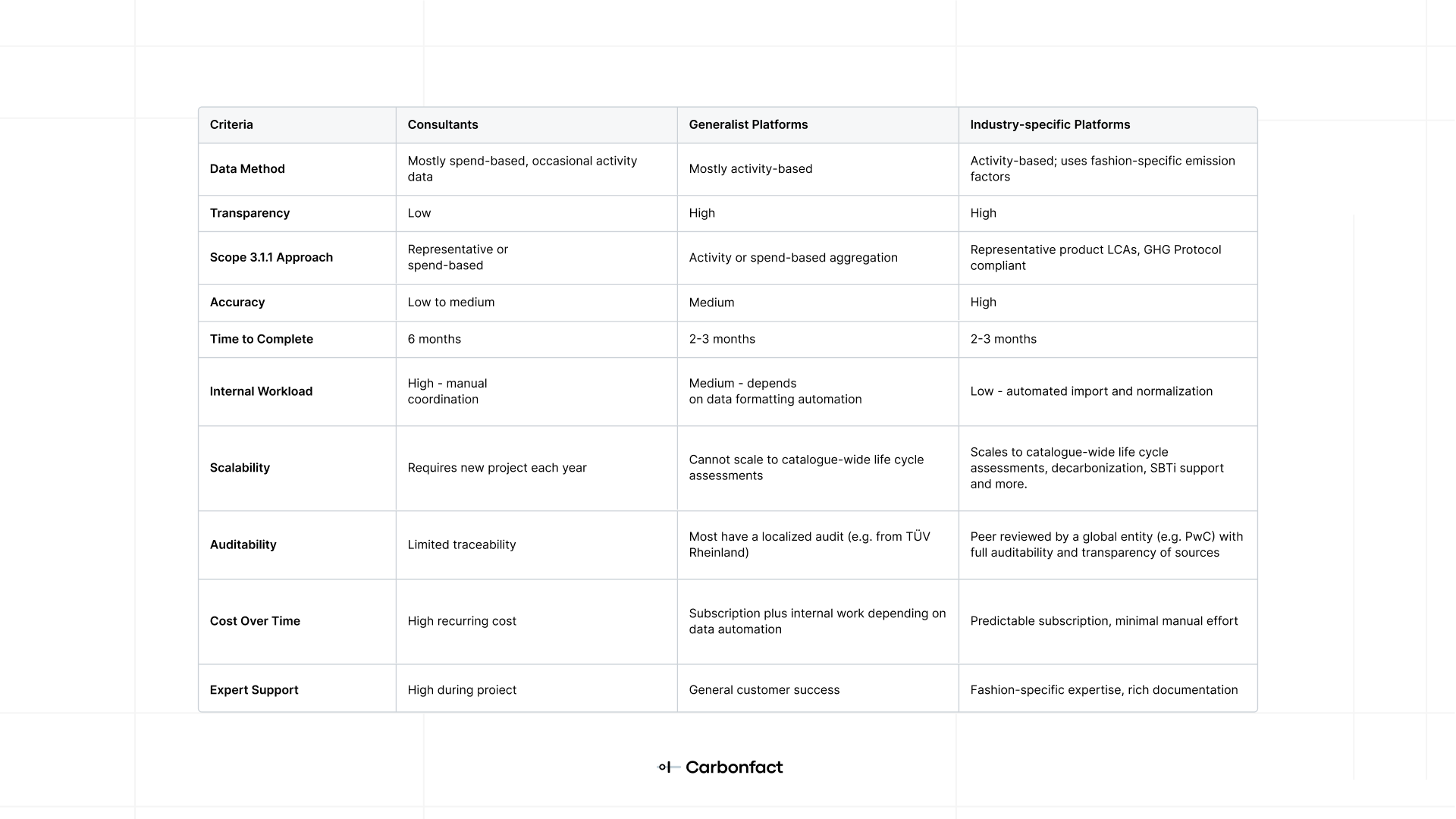
1. Industry-specific platforms
Specialist carbon accounting platforms, such as Carbonfact, are designed specifically for apparel and footwear brands. They follow the GHG Protocol while addressing the industry’s data complexity: multiple suppliers, materials, and production regions. These systems combine automation, methodological rigor, and industry-specific emission factors to deliver accurate and scalable results. They’re also set up to be future proof: no matter how regulations evolve, the same data that’s methodically collected and prepared can power reporting across multiple frameworks such as CSRD, GRI and more.
Rather than relying on manual data collection or static spreadsheets, specialist platforms automate much of the process. They import and standardize company data across Scopes 1, 2, and 3, covering energy use, logistics, and purchased goods. Some platforms use AI-powered import and normalization tools that clean and structure information automatically, allowing sustainability teams to focus on review and validation rather than administration.
For Scope 3.1.1 (Purchased Goods and Services), specialist platforms typically apply one of two approaches: an entry-level friendly one with representative products, which models the top 10-20 best sellers and scales them to total production volumes. This method is fully compliant with the GHG Protocol and delivers significantly higher accuracy than traditional spend-based approaches because it is grounded in real activity data and fashion-specific emission factors. The advanced, highly-accurate method is to run full Product Life Cycle Assessments (LCAs) across the entire product catalogue. The approach that fits your company best will depend on your goals (reporting or decarbonization?), needs and budget.
Activity-based vs. spend-based is the key distinction. Many consultants and generalist tools rely on spend-based data, estimating emissions by multiplying financial expenditures with generalized emission factors (for example, “€1 million spent on materials = X tonnes CO₂e”). While easy to gather, this approach is indirect as financial cost does not always correlate with environmental impact. Recycled nylon may cost more but produce fewer emissions than its virgin equivalent.
In calculations, activity-based uses physical quantities such as kilograms of fabric, liters of fuel, kilometers of transport. This reflects real operational activity and produces more accurate, traceable, and repeatable results. Specialist platforms are built around this logic, often enhanced by fashion-specific emission factors that reflect materials, production methods, and supply chain geography.
Advantages
- Higher accuracy and actionability through activity-based, fashion-specific data.
- Reduced manual workload with AI-assisted automation and normalization.
- Apparel-specific emission factors tailored to real production processes.
- Full traceability of data sources and emission factors.
- A foundation that can extend into product-level LCA when needed.
Limitations
- May feel like a bigger initial commitment than hiring a consultant for a one-off report
- Focused on environmental data (not a broad ESG tool)
Ideal use case
Brands with limited budget and time needing efficient and auditable carbon accounting that reduces manual effort, is actionable within 3 months and can evolve toward product-level analysis as data maturity increases.
What is Carbonfact's approach?
If you are early in your carbon accounting journey, Carbonfact supports using representative products to model Scope 3.1. You can add a set of representative products (often 10–20 best sellers or category averages) and the platform builds a company footprint using activity-based calculations rather than spend-based proxies.
Platform to evolve with: you can later expand from representative products to full product LCAs without switching tools or methodology.
2. Generic platforms
Generalist platforms provide broad ESG or carbon accounting functionality designed for multiple industries. They help companies digitize sustainability reporting through dashboards and integrations with accounting or operational systems.
Most generalist platforms rely on spend-based or high-level activity data. They automate data entry and aggregation but use generic emission factors that lack relevance to apparel supply chains. This limits precision, particularly for Scope 3.1.1, where material and supplier-specific information drives emissions.
Advantages
- More efficient than manual work or consultants
- Covers multiple sustainability topics (ESG, carbon, diversity, etc.)
- Lower cost than bespoke consulting
- Easier to centralize data across teams
- Fast setup with basic data requirements.
Limitations
- Broad, not deep → limited accuracy at product level
- Generalist expertise leads to a lack of new insights
- When plugging in directly to accountancy systems, will rely on spend-based data only
- Cannot grow with your fashion-specific needs – for example, there’s limited support for decarbonization actions
- Integration with product development or supply chain may be weak
Ideal use case
Diversified groups or early-stage companies that need consolidated reporting but do not require industry-specific precision.
3. Consultants
Consultants offer manual, project-based carbon assessments. They collect data, apply emission factors, and deliver static reports summarizing total emissions and general reduction strategies.
Their work is often based on spend or partial activity data, depending on what the company can provide. While methodologically sound, these projects are time-intensive and difficult to update or reuse for future reporting.
Advantages
- Strong methodological and contextual expertise.
- Helpful for initial baselines or investor-driven reporting.
- Tailored reports for specific frameworks (CSRD, GHG Protocol, etc.)
- Often provides strategic advice alongside reporting
Limitations
- High cost, especially for recurring reporting
- Dependence on external partner for updates and repeat projects
- Typically based on spend-based data → less accurate, not product-level
- No autonomy – dependency on consultant timelines
- Lack of transparency → most emission factors aren’t referenced
- Reports often static (hard to re-use for ongoing business decisions)
Ideal use case
Companies completing their first footprint or lacking internal sustainability capacity.
4. In-house teams
Companies with the resources and expertise may opt to build in-house carbon accounting teams. This approach allows for greater control over the process and the development of deep internal knowledge. However, it requires significant investment in personnel,training and maintenance. We won’t be diving too deeply into this as it’s generally disregarded as an option for fashion companies due to the size of sustainability teams versus the amount of effort and time required to operationalize Carbon Accounting in-house.
Selecting the Best Carbon Accounting Software for Your Fashion Brand
If you're transitioning from an existing carbon accounting system, conducting a thorough gap analysis is essential to ensure a smooth migration process. This involves identifying any compatibility issues, data transfer requirements, and potential training needs for your team.
Key features of carbon accounting software
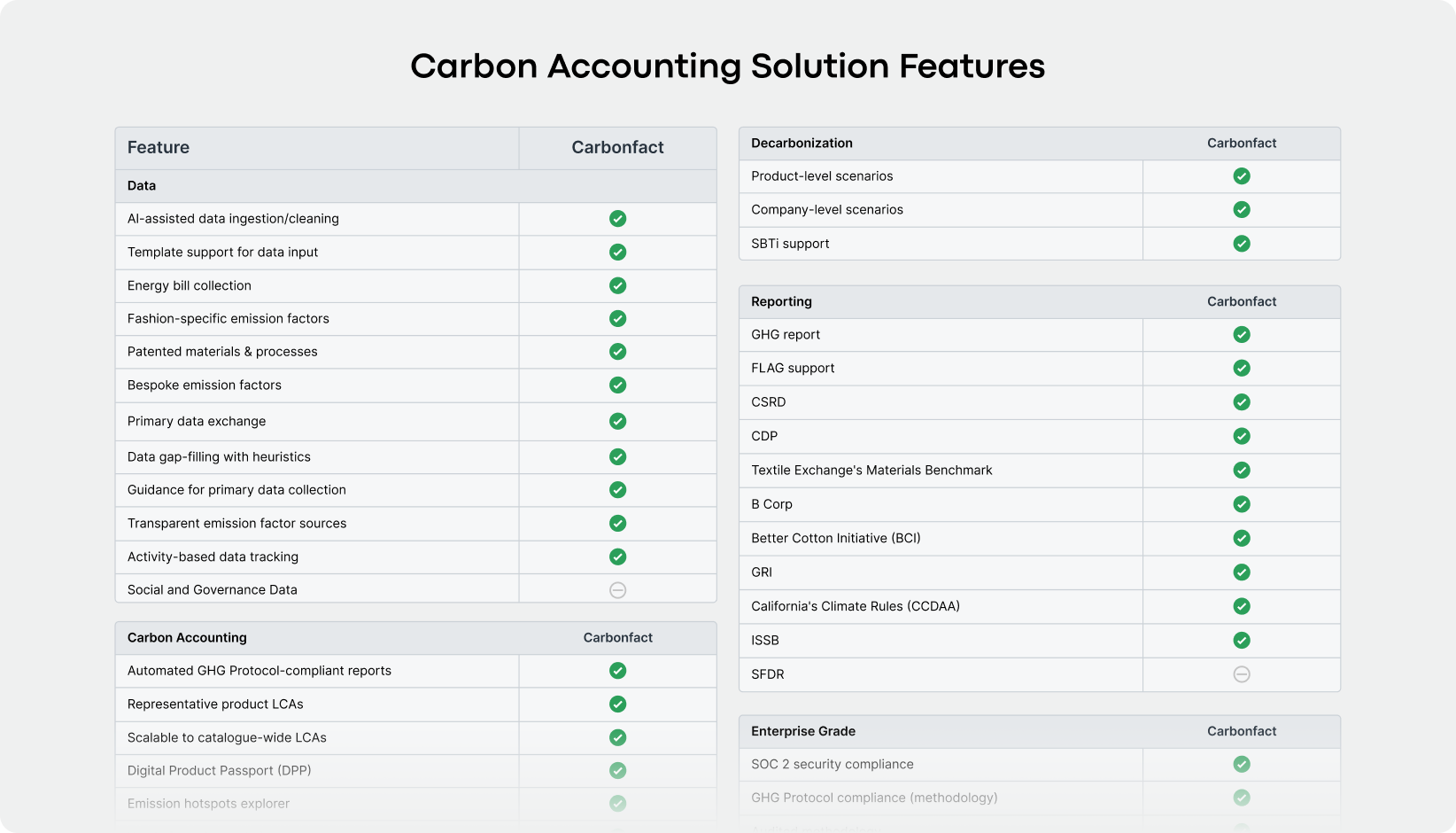
The best carbon accounting software should also offer a suite of features that empower fashion companies to effectively measure and reduce their emissions. These features include:
- Automated data collection: Automatically import and sync data from any source, in any format, eliminating the need for manual entry and minimizing data-entry errors.
- Data gap filling: The platform intelligently supplements missing information with the help of industry-specific heuristics, and helps to identify hotspots to prioritize supplier data collection.
- Standardized reports: Easily generate reports that align with industry-recognized frameworks, such as GRI, CDP, TCFD, SASB, and SECR.
- Custom reports: The ability to generate custom reports such as material baskets for ESG reports, Textile Exchange or SBTi.
- Real time updates: Ingest purchase orders, to get year-to-date data for each Scope.
- Trend analysis: Track emissions over time and identify patterns to inform strategic decision-making.
- Version control: Calculations are version controlled, transparent, documented, and auditable.
- Interactive platform: Visually represent progress with interactive graphs and tables to get a clear understanding of your company's impact.

Facility view in Carbonfact Carbon Accounting tool. Learn more.
What are Carbonfact's features?
Automated, expert-driven Carbon Accounting for apparel and footwear:
- Flexible data ingestion: platform ingests energy bill, facility information, product data, BOMs, care labels, purchase orders, supplier information, and factory data in whatever format you already use.
- Automated data cleaning: Carbonfact automatically cleans and consolidates your data, minimizing manual effort and errors.
- Data gaps filling: we fill missing values using T1–T5 supplier data, verified through running over 50 million apparel and footwear LCAs.
- Auditability: view the source, method, and emission factor behind every calculation. Aligned with GHG Protocol and reviewed by PwC.
- Auccurate data: 150K+ fashion-and region-specific emission factors ensure accurate results – even when your data isn’t perfect.
- Factories: a powerful platform feature where you can easily manage and update your factories' energy data directly on our platform heat mixes, meters, and utility bills.
- Carbonfact AI Copilot: AI assistant inside the Carbonfact platform that answers questions about features, science, and methodology, with every reply linking back to the official documentation.
Questions to Ask When Selecting Carbon Accounting Software
When building an RFP or screening different Carbon Accounting vendors, these are some questions that you should ask.
- Is the Carbon Accounting approach compliant and certified? Does it adhere to the GHG Protocol?
- Which GHG protocol scopes does the platform cover?
- Does the platform use spend- and/or activity-based Scope 1-3 measurements?
- Which primary data sources do you typically use for Scope 3 emissions calculations (particularly Category 1)?
- Which secondary / reference data sources does the platform typically use for Scope 3 emissions calculations?
- Is the solution primarily aimed at the apparel and clothing sector or is it a cross-industry solution?
- How does the solution address the most common data gaps that apparel and footwear customers encounter?
- Does the solution support automated data collection?
- Does the solution automatically generate reports for external ESG reporting frameworks? Which frameworks does it support?
- How long is the average onboarding/implementation period?


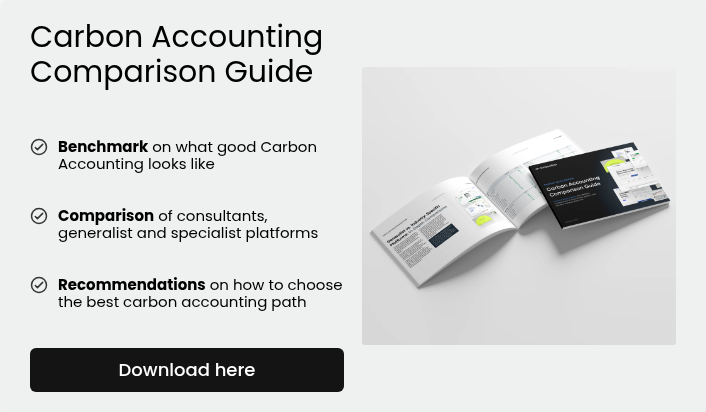







 Lidia Lüttin
Lidia Lüttin
![[Textile Industry] CSRD - Corporate Sustainability Reporting Directive Reporting Requirements for Apparel and Footwear](https://www.carbonfact.com/hs-fs/hubfs/Regulations-4.png?width=600&name=Regulations-4.png)
